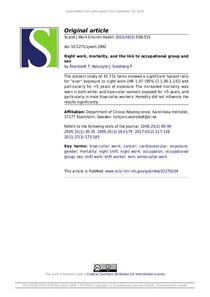Night work, mortality, and the link to occupational group and sex

Åkerstedt, Torbjörn ; Narusyte, Jurgita ; Svedberg, Pia
Scandinavian Journal of Work, Environment and Health
2020
46
5
508-515
night work ; mortality ; job exposure relation ; gender ; shift work ; high risk groups
Occupational risks
https://doi.org/10.5271/sjweh.3892
English
Bibliogr.
"Objective
Night shifts are associated with several major diseases. Mortality has been studied only to a limited extent, and the association with night shifts remains unclear. The purpose of the present study was to investigate the association between duration of night shift exposure and mortality in a large sample from the Swedish Twin Registry (the SALT cohort).
Methods
Cox proportional hazards regression models were used to analyze the data (N=42 731) over a follow-up period of 18 years, with years of night shift work as the exposure variable and adjustment for lifestyle factors and age, and stratification on gender and occupational group.
Results The hazard ratio (HR) for “ever” night shifts for total mortality was 1.07 [95% confidence interval (CI) 1.01–1.15] but 1.15 (95% CI 1.07–1.25) for longer exposure (>5 years). Also, HR for cause-specific mortality due to cardiovascular disease was significant, with higher HR for longer night shift exposure. Mortality due to cancer was significant for longer exposure only. White-collar workers showed significant HR for longer exposure. In particular, male white-collar workers showed a significant HR, with a highest value for longer exposure [HR 1.28 (95% CI 1.09–1.49)]. Heredity did not influence the results significantly.
Conclusions
Long duration of exposure to night shift work is associated with increased mortality, particularly in male white-collar workers. The lack of effects of accumulated exposure suggests that the results should be interpreted with caution."
Digital
The ETUI is co-funded by the European Union. Views and opinions expressed are however those of the author(s) only and do not necessarily reflect those of the European Union or the ETUI.